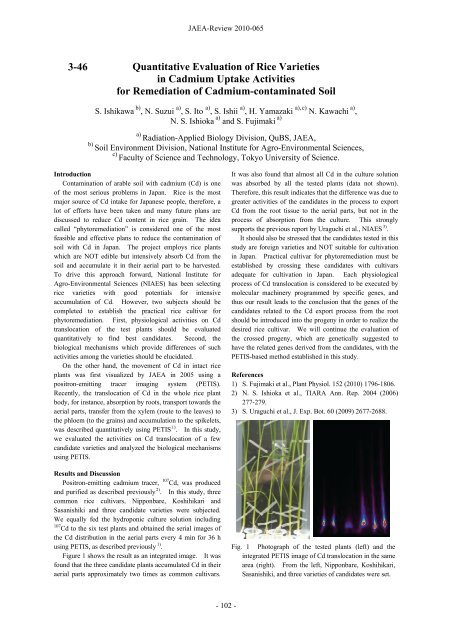JAEA-Review-2010-065.pdf:15.99MB - 日本原子力研究開発機構
JAEA-Review-2010-065.pdf:15.99MB - 日本原子力研究開発機構
JAEA-Review-2010-065.pdf:15.99MB - 日本原子力研究開発機構
Create successful ePaper yourself
Turn your PDF publications into a flip-book with our unique Google optimized e-Paper software.
3-46<br />
Quantitative Evaluation of Rice Varieties<br />
in Cadmium Uptake Activities<br />
for Remediation of Cadmium-contaminated Soil<br />
S. Ishikawa b) , N. Suzui a) , S. Ito a) , S. Ishii a) , H. Yamazaki a), c) N. Kawachi a) ,<br />
N. S. Ishioka a) and S. Fujimaki a)<br />
a) Radiation-Applied Biology Division, QuBS, <strong>JAEA</strong>,<br />
b) Soil Environment Division, National Institute for Agro-Environmental Sciences,<br />
c) Faculty of Science and Technology, Tokyo University of Science.<br />
Introduction<br />
Contamination of arable soil with cadmium (Cd) is one<br />
of the most serious problems in Japan. Rice is the most<br />
major source of Cd intake for Japanese people, therefore, a<br />
lot of efforts have been taken and many future plans are<br />
discussed to reduce Cd content in rice grain. The idea<br />
called “phytoremediation” is considered one of the most<br />
feasible and effective plans to reduce the contamination of<br />
soil with Cd in Japan. The project employs rice plants<br />
which are NOT edible but intensively absorb Cd from the<br />
soil and accumulate it in their aerial part to be harvested.<br />
To drive this approach forward, National Institute for<br />
Agro-Environmental Sciences (NIAES) has been selecting<br />
rice varieties with good potentials for intensive<br />
accumulation of Cd. However, two subjects should be<br />
completed to establish the practical rice cultivar for<br />
phytoremediation. First, physiological activities on Cd<br />
translocation of the test plants should be evaluated<br />
quantitatively to find best candidates. Second, the<br />
biological mechanisms which provide differences of such<br />
activities among the varieties should be elucidated.<br />
On the other hand, the movement of Cd in intact rice<br />
plants was first visualized by <strong>JAEA</strong> in 2005 using a<br />
positron-emitting tracer imaging system (PETIS).<br />
Recently, the translocation of Cd in the whole rice plant<br />
body, for instance, absorption by roots, transport towards the<br />
aerial parts, transfer from the xylem (route to the leaves) to<br />
the phloem (to the grains) and accumulation to the spikelets,<br />
1)<br />
was described quantitatively using PETIS . In this study,<br />
we evaluated the activities on Cd translocation of a few<br />
candidate varieties and analyzed the biological mechanisms<br />
using PETIS.<br />
Results and Discussion<br />
Positron-emitting cadmium tracer, 107 Cd, was produced<br />
and purified as described previously 2) . In this study, three<br />
common rice cultivars, Nipponbare, Koshihikari and<br />
Sasanishiki and three candidate varieties were subjected.<br />
We equally fed the hydroponic culture solution including<br />
107<br />
Cd to the six test plants and obtained the serial images of<br />
the Cd distribution in the aerial parts every 4 min for 36 h<br />
1)<br />
using PETIS, as described previously .<br />
Figure 1 shows the result as an integrated image. It was<br />
found that the three candidate plants accumulated Cd in their<br />
aerial parts approximately two times as common cultivars.<br />
<strong>JAEA</strong>-<strong>Review</strong> <strong>2010</strong>-065<br />
- 102 -<br />
It was also found that almost all Cd in the culture solution<br />
was absorbed by all the tested plants (data not shown).<br />
Therefore, this result indicates that the difference was due to<br />
greater activities of the candidates in the process to export<br />
Cd from the root tissue to the aerial parts, but not in the<br />
process of absorption from the culture. This strongly<br />
supports the previous report by Uraguchi et al., NIAES 3) .<br />
It should also be stressed that the candidates tested in this<br />
study are foreign varieties and NOT suitable for cultivation<br />
in Japan. Practical cultivar for phytoremediation must be<br />
established by crossing these candidates with cultivars<br />
adequate for cultivation in Japan. Each physiological<br />
process of Cd translocation is considered to be executed by<br />
molecular machinery programmed by specific genes, and<br />
thus our result leads to the conclusion that the genes of the<br />
candidates related to the Cd export process from the root<br />
should be introduced into the progeny in order to realize the<br />
desired rice cultivar. We will continue the evaluation of<br />
the crossed progeny, which are genetically suggested to<br />
have the related genes derived from the candidates, with the<br />
PETIS-based method established in this study.<br />
References<br />
1) S. Fujimaki et al., Plant Physiol. 152 (<strong>2010</strong>) 1796-1806.<br />
2) N. S. Ishioka et al., TIARA Ann. Rep. 2004 (2006)<br />
277-279.<br />
3) S. Uraguchi et al., J. Exp. Bot. 60 (2009) 2677-2688.<br />
Fig. 1 Photograph of the tested plants (left) and the<br />
integrated PETIS image of Cd translocation in the same<br />
area (right). From the left, Nipponbare, Koshihikari,<br />
Sasanishiki, and three varieties of candidates were set.

















